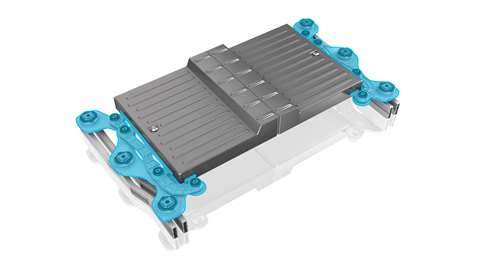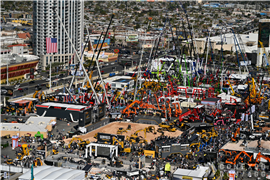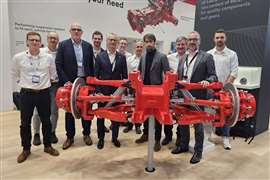Vibracoustic unveils battery pack isolation system
14 December 2022
Protecting battery is a critical NVH objective
Vibracoustic has developed a battery pack isolation system for body-on-frame vehicles such as pick-ups, off-road vehicles, large SUVs and light commercial vehicles. The company said its solution addresses some of the prevailing challenges of heavy battery packs in these vehicle classes.
 Vibracoustic has developed a battery pack isolation system for body-on-frame designs such as light commercial vehicles. (Photo: Vibracoustic)
Vibracoustic has developed a battery pack isolation system for body-on-frame designs such as light commercial vehicles. (Photo: Vibracoustic)
As electrification of the global vehicle fleet continues, OEMs are expanding the integration of battery electric vehicle (BEV) technology to new vehicle classes and platforms. Unlike most existing unibody BEVs, larger vehicles such as commercial vehicles tend to use body-on-frame (body-on-chassis) designs, which introduces significant challenges when it comes to safe and durable battery pack integration.
The battery is often the most expensive component of these larger BEVs and protecting it from unwanted loads and vibrations is a critical NVH objective. One of the primary concerns with body-on-frame vehicles is the torsional bending forces within the vehicle chassis. While this can deliver advantages for manufacturing simplicity and off-road performance, a battery pack that is rigidly mounted can be subject to potentially damaging torsional loads. Beyond the safety implications, there are also passenger comfort considerations that necessitate a well-engineered isolation solution.
Using its whole vehicle and systems-based approach to NVH performance, Vibracoustic uses multiple mounts comprised of a stamped steel housing, elastomer dampers and an extruded aluminum core. Each unit has been designed for peak loads – like those experienced during a pothole impact – of 50-60 kN. For larger battery packs, the number of mounting points can be increased to optimize NVH performance and battery pack durability. The current design can cope with all common battery packs normally weighing between 500 to 800 kilograms.
The company reported that the system has already seen success in OEM hybrid applications and is now available globally for manufacturers looking to electrify larger, body-on-frame vehicles.
POWER SOURCING GUIDE
The trusted reference and buyer’s guide for 83 years
The original “desktop search engine,” guiding nearly 10,000 users in more than 90 countries it is the primary reference for specifications and details on all the components that go into engine systems.
Visit Now
STAY CONNECTED




Receive the information you need when you need it through our world-leading magazines, newsletters and daily briefings.
CONNECT WITH THE TEAM













